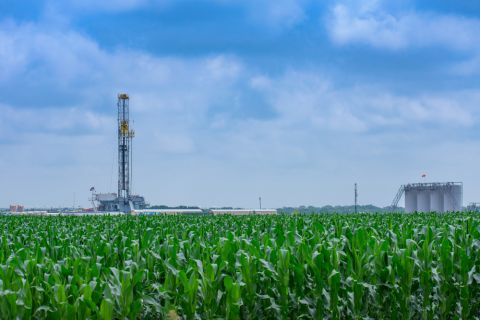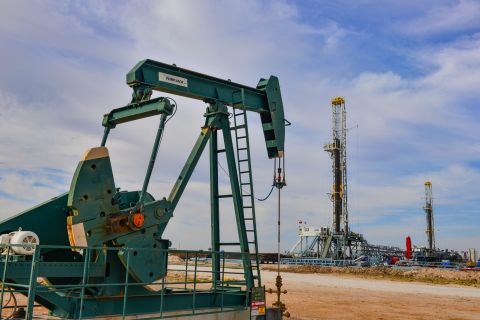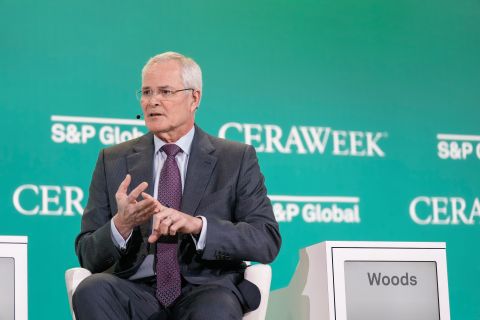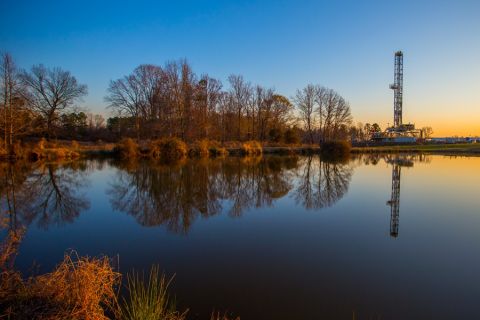
Pipeline capacity limits Appalachia
The rig count in the Marcellus and Utica plays began to climb, very slowly, late in the third quarter, continuing into November. From a low of 21 rigs in early August, the Baker Hughes report counted 38 rigs targeting the Marcellus in late November— still a far cry from a peak of 140 in early 2012. The Utica also has seen a rise in drilling, with 19 rigs making hole in November, up from 10 last spring and a peak of 50 in November 2014.
Are things turning around? Maybe, but Appalachia’s lingering takeaway capacity problems remain, according to Jean Salisbury, senior analyst with Bernstein Research.
“Even if the rigs show up, there needs to be pipeline capacity to move the produced gas to market,” Salisbury wrote in a recent report. “This will come, but not until the end of 2017.”
R.W. Baird & Co. Inc. published a report at the end of the third quarter on valuing pipeline operators going forward to factor for the potential for delays and denials. “Everywhere you look, federal agencies are slowing down pipeline construction,” it wrote.
Among the waylaid pipeline projects is PennEast, just 119 miles long in Pennsylvania and New Jersey, Baird reported. A Federal Energy Regulatory Commission (FERC) report that was due in early September on converting part of Tennessee Gas to NGL has been postponed until after the January inauguration. A city in Ohio wants a new route for another pipeline.
In addition, the Atlantic Coast and Mountain Valley lines that are to take Marcellus gas southeast drew a third-party, white-paper conclusion that existing infrastructure is sufficient. Henry Harmon, CEO of Triana Energy LLC, a producer and rig operator based in Charleston, W.Va., said the U.S. gas supply/demand market may have found equilibrium for now, but increased access to demand centers is essential, particularly in the U.S. Southeast.
“The Tidewater areas of Virginia and new markets in the Carolinas, Georgia and Florida are where the opportunity is for Appalachian producers. The Atlantic Coast and Mountain Valley pipeline projects are critical to get this gas to meaningful markets,” he said. Negative Appalachian gas differentials will narrow, “but maybe not until 2019 when all of these new markets are engaged.”
As a gas producer, Harmon added, the messaging from Washington, D.C., is confusing. “The whole impetus was to get the coal-fired (power-generation) plants converted to gas to have the carbon savings and it’s worked. We’re meeting those arbitrary targets, and now we’re not being allowed to get the gas to those new markets.”
He believes November’s election results will give the energy business an idea of what to expect in the next four years: “It will get better or worse. It won’t be the same.”
—Nissa Darbonne
Trump policies could benefit midstream projects
After an ugly, seemingly interminable campaign voters surprisingly chose Republican Donald J. Trump as the next president of the United States.
While many oil and gas industry executives had steeled themselves for a Hillary Clinton administration, they now find themselves asking: What does a Trump administration mean for the industry?
Tudor, Pickering, Holt and Co. (TPH) was unsure of what a Trump victory means for energy.
“We don’t know. But there are some clues,” TPH said in a report after the election. “Trump campaigned on reducing regulation. Maybe the EPA [U.S. Environmental Protection Agency] will be less aggressive in using the Endangered Species Act to block development? Trade with Mexico—will gas exports to Mexico go under or through the wall? Bigger picture—do his economic policies help [or] hinder economic growth [hydrocarbon demand]?”
To some extent, it won’t mean as much as some may think.
“One of the things I think was probably true either way the election would have gone is that market forces tend to have a bigger impact on energy investment than government policy,” Bill Arnold, professor in the practice of energy management at Rice University, told Hart Energy.
Arnold believes, however, that the Trump administration will favor infrastructure projects like pipelines, and the 3,500 or so political appointees at the Department of Energy and the EPA will assist in clearing regulatory hurdles in support of those policies.
That could mean that many of the projects now in limbo could go forward, but not necessarily all. Low commodity prices and limited financing options have also dampened enthusiasm.
Trump is on record as saying that, if elected, he would urge TransCanada Corp.to renew its Keystone XL permit application, which was rejected by the Obama administration to scorn of industry groups, particularly the American Petroleum Institute.
“Even if the administration were favorably inclined to give it permits, given what’s happened, given the cost structures in Canada, [TransCanada] may not be as eager as they were a couple of years ago to proceed with that,” Arnold said.
—Joseph Markman
Shale gas output complicates processing
Operators are encountering more complex challenges with the processing of varying compositions of NGL and condensate. In shale-related gathering systems, condensate is frequently encountered in various compositions as gas makes its way from the wellhead to the processing plant.
New oil and gas production over the past five years contains more condensate and NGL. New gas processing facilities are being designed to handle both off-specification condensate and NGL. For these moderate- sized facilities, pipeline, truck loading and unloading terminal investment are an important consideration, but many of the processing units will require further upgrading if these facilities plan to deliver NGL that meet pipeline specifications or condensate with a sulfur content of less than 10 parts per million—near zero.
Because of the dramatic increase in NGL and condensate production, liquids processing must be carefully designed with close attention to surrounding processes already in place. Construction of condensate splitter units leveled off by 2015, but variations in operating practices have required improvements to these recently installed assets, as well as other types of gas processing facilities. These ongoing improvements and changes will probably continue in spite of the current industry downturn. Potential issues with facilities processing condensate and NGL will keep the hydrocarbon processing industry busy from an engineering perspective.
Besides maintaining the pipeline gathering network for expanded oil and gas production operations, some of the engineering challenges in gas processing, particularly with NGL and condensate, include the elimination of flaring or venting from the wellhead to the midstream processing facilities. This is why vapor recovery units are becoming mandatory at new and existing gas processing facilities, which is a challenge since there are now many small, in-the-field plants that need upgrading. In fact, the industry is still weighing options as more expertise is needed to solve these technical challenges while the shale industry remains robust even after two years of low global crude prices.
According to a report co-authored by Jeff Stake at Allied Equipment Inc., producers who have to operate relatively small gas processing and gathering system are now dealing with liquids (e.g., condensate) and low-pressure vapors that weren’t planned for in the past. Stake mentioned the important operational assets to focus on, including:
• Condensate mercaptan treatment; • Stabilization; • Fractionation; • Hydrocarbon molecular sieves; • Triethylene glycol dehydration; • Amine treatment followed by desulfurization; • Compression (sulfide scrubbers, interstage scrubbers, discharge scrubbers); and • Expanded utility systems.
Considering these individual components collectively, Stake noted that each case must be looked at individually in terms of the quality of gas, type of facility, transportation options and contractual specifications. Also noted was that in all cases, the system under consideration should be modeled using a process simulator to predict the quality and quantity of condensate produced, and to optimize the process for each individual facility. Eventually, performance of extensive cash flow analysis of field-to-gas plant operations will, in many cases, justify financing the expansion of existing assets.
—Rene Gonzalez
Midstream must tell its story better
The midstream serving the Appalachian unconventional plays has significant growth opportunities, but it needs to “up its communications game” with the public to assure needed infrastructure gets built.
That was the theme of Patrick Henderson, director of regulatory affairs for the Marcellus Shale Coalition, in a presentation at the annual Midstream PA conference in State College, Pa. The public has legitimate questions about new pipelines, gas plants and other infrastructure. It’s important for the industry to take time and adequately address those questions, Henderson said.
“This is new to them; there is no recent history of oil and gas, and it’s fair that they have questions,” he added. “They are not an obstacle to get around, they are the end game—the consumers. They are ultimately important to success.”
But the industry also should identify its opponents and recognize there is a core group firmly opposed to the development of all fossil fuels, and no arguments will persuade their deeply held beliefs, Henderson said.
“You can persuade some, and some not,” he said. “The opponents are not persuadable, they don’t care. All of us have been in those conversations. It’s important to target your message to the right audience.” What the industry can gain, however, is awareness of the successful communications methods employed by these opponents, Henderson noted.
The conference, held on the Pennsylvania State University campus, featured presentations by a dozen industry, government and trade group representatives.
Henderson said the industry’s rapid growth in the region makes it a common topic of public discussion. He added that the Keystone State rose from 15th in U.S. natural gas production in 2008 to No. 2 in 2015. Its production continues to rise, he said, as does production from Ohio and West Virginia.“This is a high-performance industry across the board,” he said.
That growth—in a region beset by years of economic decline—can create strong public support for the industry, Henderson emphasized, if the public learns more and gives it strong support.
“We need to articulate the benefits better and more consistently” to a public that generally knows little about the business. “We need to look at ourselves in the mirror and do a better job of telling our story,” he said.
Henderson said that the segment’s “market challenges must equal opportunities,” and public support will be necessary if the midstream expects to build out the infrastructure that Appalachian producers need.
—Paul Hart
Tightening LNG markets to spark project decisions
Lower prices have been one reason for the delay in final investment decisions (FIDs) for LNG projects worldwide. The majority of FIDs in 2015 were for U.S. projects, hoping to take advantage of the lower prices to attract buyers.
At the start of 2015, FIDs were targeted on 98.8 million metric tons per year (MMmt/y) of capacity. However, FIDs were made on only 19.3 MMmt/y—Sabine Pass Train 5, Corpus Christi trains 1 and 2 and Cameroon floating LNG (FLNG).
In April 2016, there were 15 projects targeting FIDs in 2016 for a total capacity of 92.7 MMmt/y—six in the U.S., five in Canada, two in Mozambique, one in Equatorial Guinea and one in Indonesia, according to Andy Flower of Flower LNG, in “LNG Supply Outlook 2016 to 2030,” published by the Bureau of Economic Geology’s Center for Energy Economics at the University of Texas at Austin.
As Patrick Pouyanne, chairman and CEO of Total, noted in the company’s recently published 2016 Strategy and Outlook, “There is still some room for sanctioning projects for between 2020 to 2025.”
Since it takes about four years to build a liquefaction plant, FIDs made in 2017 to 2018 would be ready to take advantage of increased demand and potential lower LNG supply.
Anadarko Petroleum Corp. still expects to make its FID on the Mozambique LNG project by the end of this year. Construction could begin in 2017 or more likely 2018. It would probably take longer to build the greenfield plant in Mozambique because of the lack of industrial support, skilled laborers and infrastructure.
In July, LNG Canada delayed an FID, which was originally planned for the end of 2016, on the LNG project. In a press release, the joint-venture participants—Royal Dutch Shell Plc, PetroChina Co. Ltd., Mitsubishi Corp. and KOGAS said, “In the context of global industry challenges, including capital constraints, the LNG Canada joint-venture participants have determined they need more time prior to taking an FID. At this time, we cannot confirm when this decision will be made.”
An FID on another Canadian project— Pacific NorthWest LNG—has also been delayed due to weakening demand in Asia and Europe. The Canadian government placed 190 conditions on the approval of the $36-billion project.
Alta Gas cancelled its Douglas Channel FLNG plant due to unfavorable market conditions.
FERC denied the application for Veresen’s Jordan Cove facility in Oregon earlier this year. Three other U.S. projects were cancelled—Lavaca Bay FLNG, South Texas FLNG trains 1 and 2 and Gasfin LNG.
“The success rate of FIDs in 2016 is unlikely to be better than in 2015, and it could be 10% or lower of the targeted total since all the projects in the table are struggling to secure binding commitments for buyers or off-takers willing to commit to a 20-year project,” Flower said.
The one exception is Kinder Morgan’s Elba Island LNG project, which has a 20-year contract with Shell. Construction on the plant was scheduled to begin in the third quarter and be placed in initial service in 2018.
—Scott Weeden
Does the U.S. have the will for its energy?
The U.S. energy business is in an enviable position today, thanks to the boom in unconventional plays that has occurred in the last decade. But a serious question lingers: Does the nation have the will to make the most of that advantage?
The industry itself has a major role in answering that question, according to Karen Harbert, president and CEO of the Institute for 21st Century Energy, sponsored by the U.S. Chamber of Commerce.
“Is the energy economy rebounding or faltering?” following the commodity price downturn, she asked in her keynote address at the INGAA Foundation’s annual meeting, held at Pebble Beach, Calif. The November conference drew a record crowd of nearly 500 midstream operators and suppliers.
“No industry has changed itself so rapidly,” Harbert added. “We are now in a dominant position worldwide, an inconvenient truth for Russia and Saudi Arabia.” She gave her presentation immediately following a trade mission to Saudi Arabia, which she termed “challenging” given the world’s current energy situation.
Unfortunately, most of the American public is unaware of how important the energy business is to the nation’s economy, she explained in her address.
“You are what got us through this recession. If it had not been for the energy renewal, we would not have had a recession but a depression,” she said. “You are what saved us,” Harbert added, pointing to thousands of jobs the industry added during the shale boom, the sharp reduction in energy mports—and balance of payments deficit— and the rise in energy-dependent petrochemical industries.
“The reduction in imports meant there was money left here, to be invested here,” she said. The shale boom dramatically reduced energy prices that, although a pain point now for the industry, will be a longterm gain for the U.S.
Harbert noted electricity costs, on average, in much of Western Europe are four times what they are in the U.S., which has the second-lowest power costs in the developed world behind Norway, which has vast, low-cost hydroelectric capacity that canno be duplicated elsewhere. European gasoline prices at the pump are three times the U.S. average, she said.
European firms are taking note, and that has spurred a growing move here and the addition of new U.S. petrochemical capacity, especially fertilizer and plastics production. “BASF is a U.S. firm now for all intents and purposes,” she added. “Energy represents one-third of all [U.S.] investment” currently, Harbert said.
Today’s energy situation is a far cry from gloomy projections the federal government made a decade ago while she served as an assistant secretary of energy in the George W. Bush administration, she noted. Instead of falling domestic reserves and a scramble to find new sources of imported oil and gas, the industry’s biggest challenge today is to make the public aware of national energy abundance—and that will not be easy given the success of environmental groups and the growing animosity of regulators to energy development.
“Now is the time to reset the narrative,” she told the conference. Emphasizing the industry’s positives, particularly to millennials, is critically important.
Contrary to a general view that the energy business is a backward, pollution-generating business, “there is no industry that is more technology-driven than you are: You are high-tech, and millennials need to know that and how important you are.”
It will be critical to engage the new Trump administration and a new Congress in the need for further development of energy infrastructure, she added.
It’s vital that the energy business “needs to put a human face on” to counteract that trend, Harbert said. “There are all kinds of stories we can tell. We all have dreams and energy can fulfill them.” That means making the public aware that oil and gas are more than motor fuels but also the feedstocks of products as diverse as shoes and hospital IV tubing.
—Paul Hart
New York’s pipeline veto could be pricey
The legal battle over the Constitution Pipeline could represent a new tangent in environmentalist strategy—or just a continued ramp-up of the conflict between developers and regulators in New York state, a report speculates.
Either way, repercussions could include billions of dollars in infrastructure investment at risk, gas and power price spikes in the Northeast and a new round of regulatory uncertainty, according to a joint article by S&P Global Market Intelligence and S&P Global Platts.
With a 2014 consumption of 1.35 trillion cubic feet (Tcf), New York ranks fourth behind Texas, California and Louisiana— and just ahead of Florida—in the EIA’s list of top gas-consuming states. New York also sits atop technically recoverable gas resources that could surpass 7 Tcf, but a law banning hydraulic fracturing that went into effect in June 2015 makes the state dependent on imports.
The 124-mile, $925-million Constitution Pipeline was designed to connect the Marcellus in Pennsylvania to markets in New York and New England. It was approved by FERC but denied a water quality permit by the New York State Department of Environmental Conservation in April.
The pipeline has come under considerable pressure from environmentalists, and its cancellation was demanded by U.S. Sen. Bernie Sanders (D-Vermont) during his unsuccessful bid for the Democratic presidential nomination. It has also been, oddly, referred to as a “fracking pipeline” by The Intercept, an online news outlet known for reporting documents released by Edward Snowden.
The article notes the strategic location of the state in the Appalachian Basin, where shale plays exist along with high-volume demand and premium-priced markets in New England, positions it to host other pipelines. Those include Millennium Pipeline Co. LLC’s proposed Eastern System upgrade and Northern Access 2016, a National Fuel Gas Co. project. Combined, the projects could move up to 1.4 billion cubic feet per day.
Without easy access to those markets, customers in the region will continue to experience price volatility, and energy companies will be tempted to move that gas toward surging demand areas in the Southeast and Gulf Coast, the article said.
The move to deny the water quality permit, despite FERC approval, also places the state in defiance of the federal government.
“If you allow a state to circumvent the Natural Gas Act, you have impermissibly amended the Natural Gas Act, and that is contrary to the intent of Congress,” Marc Spitzer, a former FERC commissioner and now a partner with Steptoe & Johnson LLP, told S&P Global Intelligence.
The U.S. Second Circuit Court of Appeals is expected to rule this winter on the denial of the water permit. The Interstate Natural Gas Association of America, along with other industry groups, recently filed a friend of the court brief in support of Constitution’s lawsuit.
—Joseph Markman
Recommended Reading
Enverus: 1Q Upstream Deals Hit $51B, but Consolidation is Slowing
2024-04-23 - Oil and gas dealmaking continued at a high clip in the first quarter, especially in the Permian Basin. But a thinning list of potential takeout targets, and an invigorated Federal Trade Commission, are chilling the red-hot M&A market.
Mighty Midland Still Beckons Dealmakers
2024-04-05 - The Midland Basin is the center of U.S. oil drilling activity. But only those with the biggest balance sheets can afford to buy in the basin's core, following a historic consolidation trend.
EIA: Permian, Bakken Associated Gas Growth Pressures NatGas Producers
2024-04-18 - Near-record associated gas volumes from U.S. oil basins continue to put pressure on dry gas producers, which are curtailing output and cutting rigs.
CEO Darren Woods: What’s Driving Permian M&A for Exxon, Other E&Ps
2024-03-18 - Since acquiring XTO for $36 billion in 2010, Exxon Mobil has gotten better at drilling unconventional shale plays. But it needed Pioneer’s high-quality acreage to keep running in the Permian Basin, CEO Darren Woods said at CERAWeek by S&P Global.
Mesa III Reloads in Haynesville with Mineral, Royalty Acquisition
2024-04-03 - After Mesa II sold its Haynesville Shale portfolio to Franco-Nevada for $125 million late last year, Mesa Royalties III is jumping back into Louisiana and East Texas, as well as the Permian Basin.





